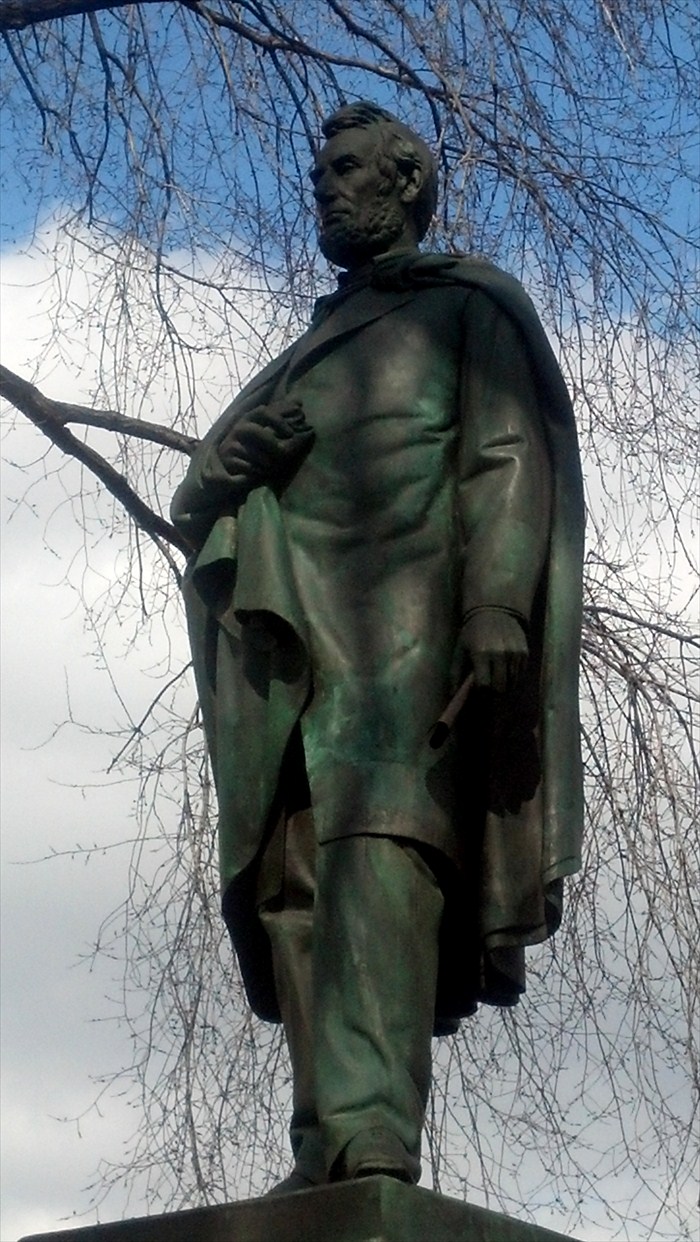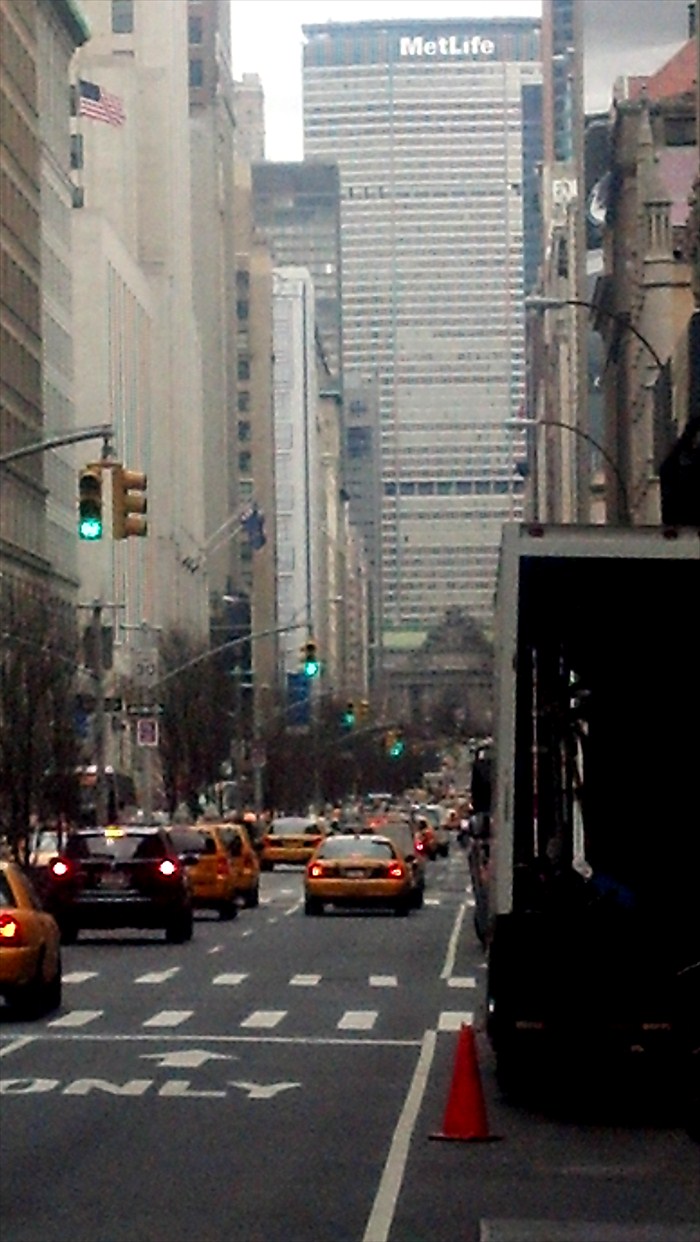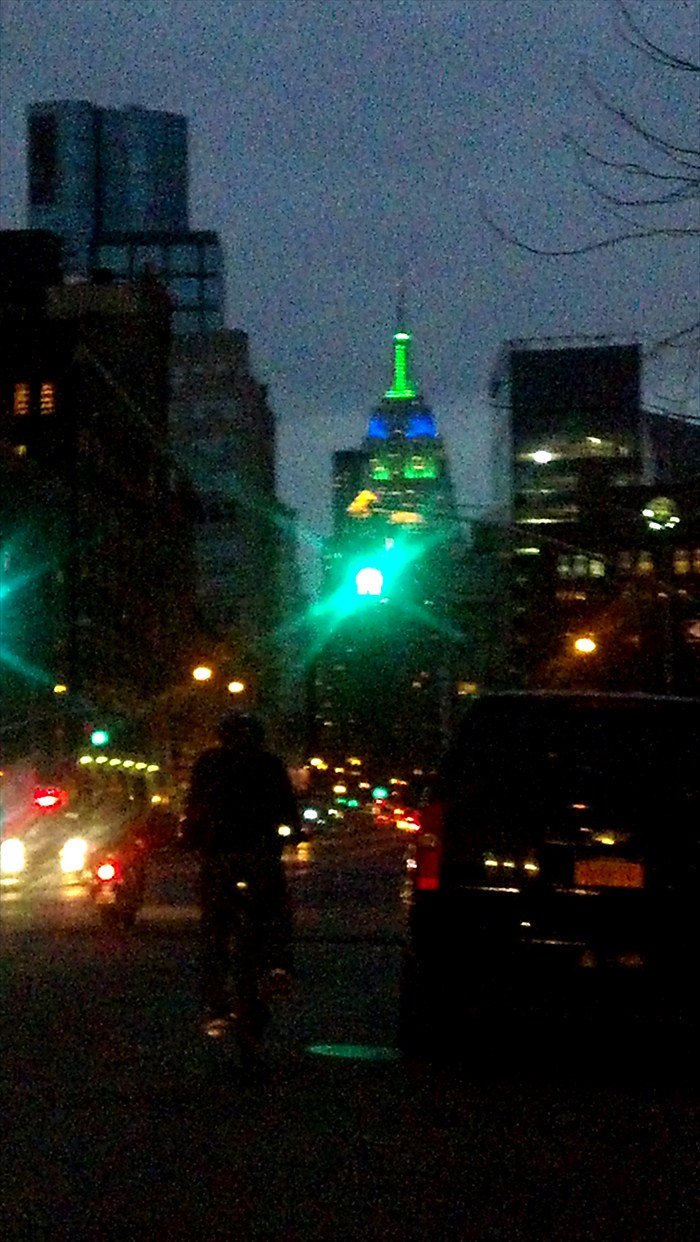Winter Walk-Off 2013

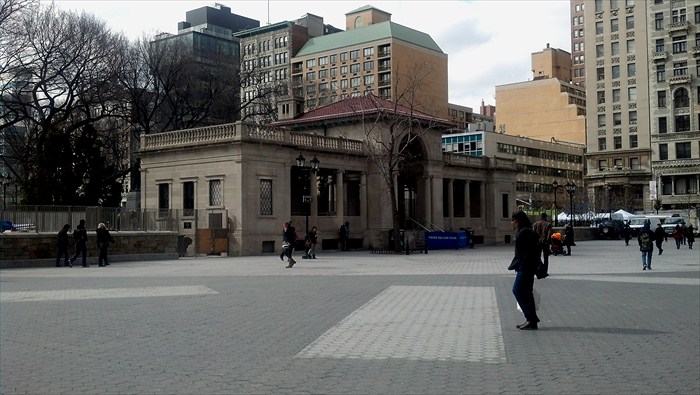 For the past several years Les of The Tidewater Gardener has issued an annual challenge to take a walk from your house and post on what you see. It's okay to drive to the place you want to start your walk, but you have to walk. No photos of your own garden are allowed. I've always meant to participate but never have. So here goes, though I'm not sure I'm complying with all the rules. This is about a walk, a subway ride, a drive, and a lecture in New York City. I hope my geographical disadvantage will permit this to qualify.On Monday I was at work at 19th and Park Avenue South, just north of Union Square, where I work two days each week. Armed with my cell phone camera, I took a quick walk and subway ride downtown to Wall Street to meet my friend Cathy for lunch. I passed the open space at the north end of the park (above) where a fabulous farmer's market is held four days a week. Not much going on there, but it was a cold, blustery day.I did see a few sparrows perching in these magnolias at the edge of a playground.
For the past several years Les of The Tidewater Gardener has issued an annual challenge to take a walk from your house and post on what you see. It's okay to drive to the place you want to start your walk, but you have to walk. No photos of your own garden are allowed. I've always meant to participate but never have. So here goes, though I'm not sure I'm complying with all the rules. This is about a walk, a subway ride, a drive, and a lecture in New York City. I hope my geographical disadvantage will permit this to qualify.On Monday I was at work at 19th and Park Avenue South, just north of Union Square, where I work two days each week. Armed with my cell phone camera, I took a quick walk and subway ride downtown to Wall Street to meet my friend Cathy for lunch. I passed the open space at the north end of the park (above) where a fabulous farmer's market is held four days a week. Not much going on there, but it was a cold, blustery day.I did see a few sparrows perching in these magnolias at the edge of a playground.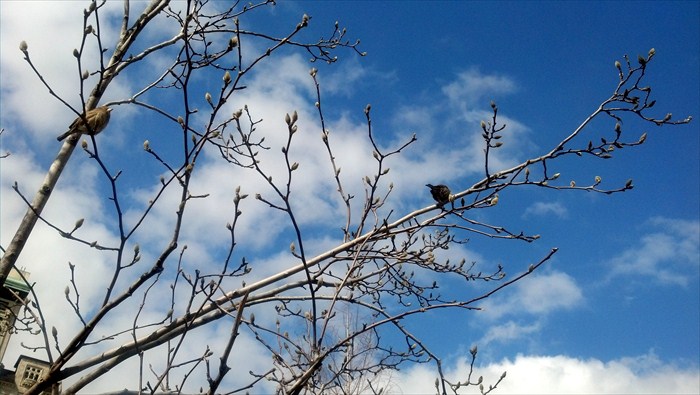 Union Square Park has several statues of people important in American history (and a wonderful statue of Gandhi in a little parklet at one corner). Obviously, this is a statue of Abraham Lincoln, which seems appropriate since Daniel Day Lewis had won best actor only the night before for his performance as Lincoln.
Union Square Park has several statues of people important in American history (and a wonderful statue of Gandhi in a little parklet at one corner). Obviously, this is a statue of Abraham Lincoln, which seems appropriate since Daniel Day Lewis had won best actor only the night before for his performance as Lincoln.
The park was empty. Not a day for eating lunch outside.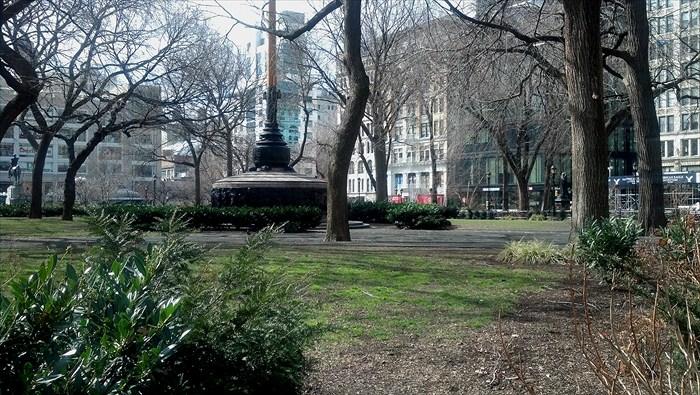 These American elms amazingly survive in pockets of soil above a massive subway complex. Even in winter, their squiggly forms, reflected by their shadows on the ground, provide a lot of visual interest.
These American elms amazingly survive in pockets of soil above a massive subway complex. Even in winter, their squiggly forms, reflected by their shadows on the ground, provide a lot of visual interest. Before I got to the subway entrance, I passed the statue of the Marquis de Lafayette.
Before I got to the subway entrance, I passed the statue of the Marquis de Lafayette. There's also a large, imposing equestrian statue of George Washington at the southern park entrance, but I didn't see that one. Instead I entered the subway.
There's also a large, imposing equestrian statue of George Washington at the southern park entrance, but I didn't see that one. Instead I entered the subway. And within ten minutes, I was about three miles to the south at Wall Street.
And within ten minutes, I was about three miles to the south at Wall Street. I came up the stairs across from Trinity churchyard ...
I came up the stairs across from Trinity churchyard ...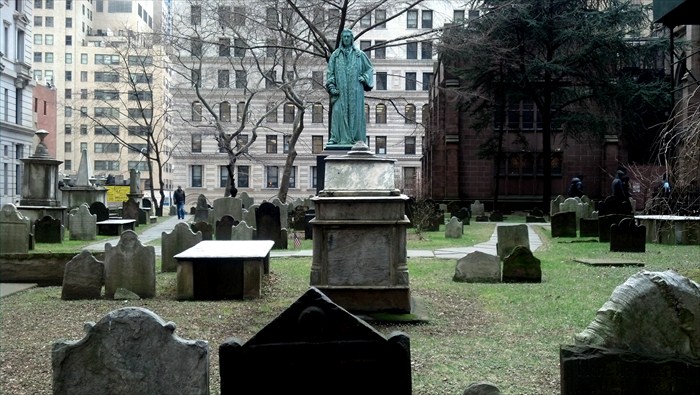 ... where Alexander Hamilton, among many other illustrious New Yorkers, is buried.Here is a look down Wall Street. Part way down the street is Federal Hall, which marks the site where George Washington was inaugurated as our first President. And at no.57 Wall Street Alexander Hamilton lived with his family for ten years. (All the security barriers spoil the view.)
... where Alexander Hamilton, among many other illustrious New Yorkers, is buried.Here is a look down Wall Street. Part way down the street is Federal Hall, which marks the site where George Washington was inaugurated as our first President. And at no.57 Wall Street Alexander Hamilton lived with his family for ten years. (All the security barriers spoil the view.)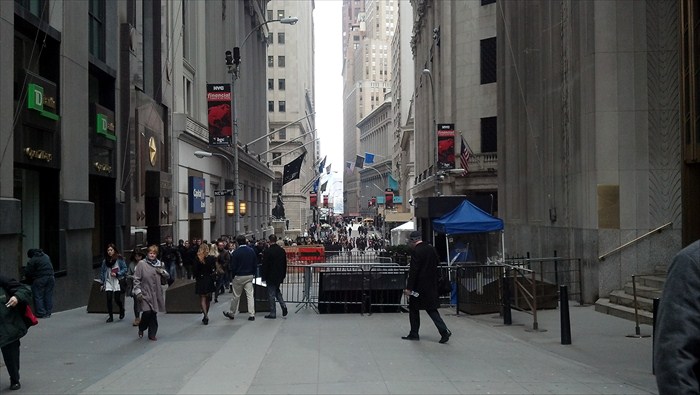 I met Cathy, and on the way to lunch we passed one of my favorite places in the city--this notable plaza with sculpture and skyscraper on Broadway between Cedar and Liberty streets. The building, designed by Gordon Bunshaft of Skidmore, Owings & Merrill and completed in 1967, is paired with the Red Cube sculpture by Isamu Noguchi.
I met Cathy, and on the way to lunch we passed one of my favorite places in the city--this notable plaza with sculpture and skyscraper on Broadway between Cedar and Liberty streets. The building, designed by Gordon Bunshaft of Skidmore, Owings & Merrill and completed in 1967, is paired with the Red Cube sculpture by Isamu Noguchi.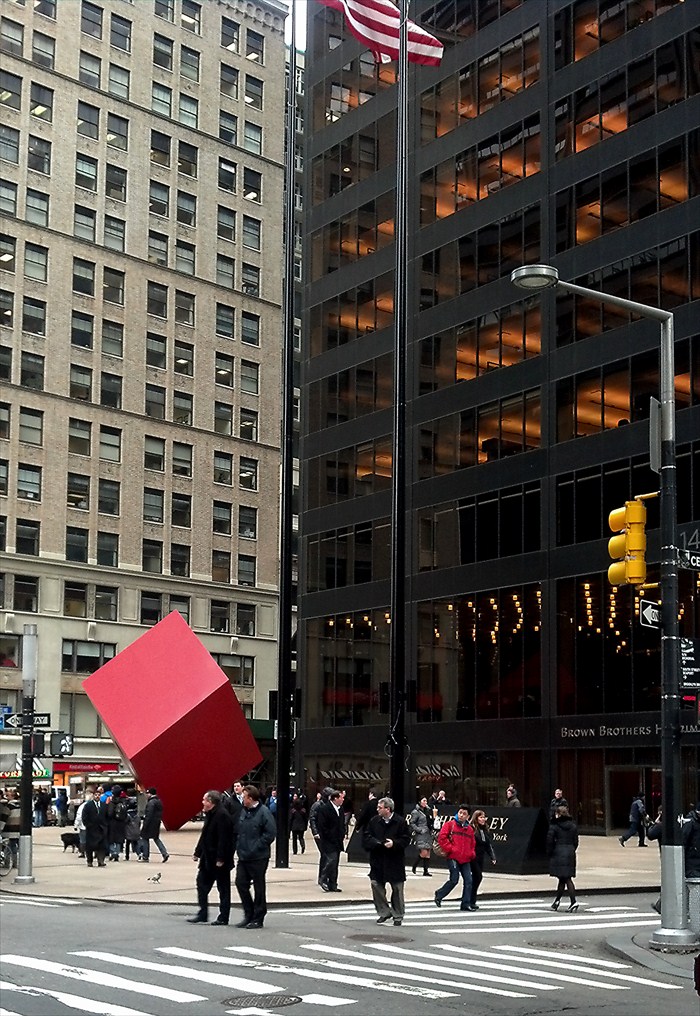 This is considered by many to be one of the great public spaces in the city. To quote Ada Louise Hustable, the former architecture critic of the New York Times, in her March 31, 1968, review: "This small segment of New York compares in effect and elegance with any celebrated Renaissance plaza or Baroque vista. The scale of the buildings, the use of open space, the views revealed or suggested, the contrasts of architectural style and material, of sculptured stone against satin-smooth metal and glass, the visible change and continuity of New York's remarkable skyscraper history; the brilliant accent of the poised Noguchi cube--color, size, style, mass, space, light, dark, solids, voids, highs and lows--are all just right. These few blocks provide (why equivocate?) one of the most magnificent examples of 20th-century urbanism anywhere in the world."Well! Someone should tell that to the people you see scampering across Broadway in the photo.I've always found part of the magic of this space is in the way the massive building gracefully meets the ground. You can stand right next to it and feel as if you're standing beside a familiar house. You don't feel dwarfed by opressive, discomforting, massive scale, as you so often do standing at the base of such a large building. Of course the Noguchi sculpture is is essential to making this space work. I may be over reaching a little, but I think I could make a case for calling this a garden. (I've read that the sculpture and its position within this space was greatly influenced by Noguchi's experience designing gardens in the preceding decades; there's probably another blog post to be done on that subject.)After lunch I headed back uptown (though 19th Street is not really uptown), and took this shot looking up Park Avenue in front of my building.
This is considered by many to be one of the great public spaces in the city. To quote Ada Louise Hustable, the former architecture critic of the New York Times, in her March 31, 1968, review: "This small segment of New York compares in effect and elegance with any celebrated Renaissance plaza or Baroque vista. The scale of the buildings, the use of open space, the views revealed or suggested, the contrasts of architectural style and material, of sculptured stone against satin-smooth metal and glass, the visible change and continuity of New York's remarkable skyscraper history; the brilliant accent of the poised Noguchi cube--color, size, style, mass, space, light, dark, solids, voids, highs and lows--are all just right. These few blocks provide (why equivocate?) one of the most magnificent examples of 20th-century urbanism anywhere in the world."Well! Someone should tell that to the people you see scampering across Broadway in the photo.I've always found part of the magic of this space is in the way the massive building gracefully meets the ground. You can stand right next to it and feel as if you're standing beside a familiar house. You don't feel dwarfed by opressive, discomforting, massive scale, as you so often do standing at the base of such a large building. Of course the Noguchi sculpture is is essential to making this space work. I may be over reaching a little, but I think I could make a case for calling this a garden. (I've read that the sculpture and its position within this space was greatly influenced by Noguchi's experience designing gardens in the preceding decades; there's probably another blog post to be done on that subject.)After lunch I headed back uptown (though 19th Street is not really uptown), and took this shot looking up Park Avenue in front of my building.
It may say MetLife but to me it will always be the Pan Am Building. You can see a blurry Grand Central Terminal at its base.After work I went to the third in a series of free lectures on ecological urbanism. They're being held at The Cooper-Union. Parking becomes legal at 6 p.m. on the Bowery, so I drove down (only a few blocks from work) and waited in the car until I was legal, then walked to The Cooper-Union.The Bowery is a very old street, originally going back to a Lenape Indian path running the length of Manhattan Island. This is a view up the Bowery and 4th Avenue looking toward the Empire State Building, now in its St. Patrick's Day regalia.
When the Dutch ruled New York, Peter Stuyvesant had a farm (Bowerij) right here, where he retired in 1667, just before the British took control of the city. Here is a quotation from Wikipedia that gives you some feeling for how things have changed in this part of Manhattan."In her Journal of 1704–1705, Sarah Kemble Knight describes the Bowery as a leisure destination for residents of New York City in December:
- Their Diversions in the Winter is Riding Sleys about three or four Miles out of Town, where they have Houses of entertainment at a place called the Bowery, and some go to friends Houses who handsomely treat them. [...] I believe we mett 50 or 60 slays that day—they fly with great swiftness and some are so furious that they'le turn out of the path for none except a Loaden Cart. Nor do they spare for any diversion the place affords, and sociable to a degree, they'r Tables being as free to their Naybours as to themselves."
So, though I didn't see any actual gardens on my trek, I did visit a notable park, a "conceptual" park at the plaza with the Noguchi Red Cube and the Bunshaft building, and a farm, or what was once a farm about 350 years ago.And I ended the day with a lecture on a new field of study, ecological urbanism, that may help us make more sustainable, liveable cities in the world of the 21st century. I'll should add that the lecture was held in The Great Hall, where Abraham Lincoln spoke as he was beginning his campaign for a second term as President. (Just about every famous person in American history has spoken in The Great Hall.)It appears my winter walk-off turned out to be quite a day.
